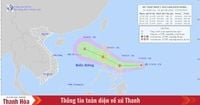Authorities across Vietnam’s central and northern coastal regions are bracing for the arrival of a tropical depression near the East Sea, which forecasters warn could intensify into a storm within the next 24 hours. The system, currently designated as 96W and named Ramil internationally, is situated over the eastern sea area of Central Philippines, with its center at approximately 13.5 degrees North latitude and 130.2 degrees East longitude. According to the Joint Typhoon Warning Center (JTWC), as of 16:00 on October 17, 2025, the disturbance is showing signs of strengthening as it moves westward at 20 to 25 kilometers per hour, with maximum sustained winds near the center reaching 35 to 45 kilometers per hour and a central pressure estimated at about 1007 hPa.
The Vietnamese government has responded with urgency. On October 17, 2025, the National Steering Committee for Disaster Prevention and Control issued official dispatches to the People’s Committees of 15 coastal provinces and cities, ranging from Quang Ninh in the north to Lam Dong in the south, instructing local authorities to proactively implement a series of disaster preparedness measures. The Provincial Steering Committee for Disaster Prevention and Control of Thanh Hoa, for instance, circulated official dispatch No. 29/PTDS to relevant departments and coastal localities, emphasizing the need for vigilance and readiness as the tropical depression approaches.
JTWC’s analysis paints a concerning picture. Satellite imagery reveals that the low-pressure system is consolidating, with thick convection clouds indicating the storm’s potential to intensify. Meteorological experts point to a combination of favorable factors fueling the depression’s growth: robust upper-level outflow, warm sea surface temperatures ranging from 30 to 31 degrees Celsius, and weak vertical wind shear from the northwest. All these elements, according to JTWC, create an environment ripe for tropical cyclone development. Global forecast models are in agreement, predicting that system 96W will likely strengthen and track northwestward into the East Sea within the coming day.
Local authorities are not taking any chances. The National Steering Committee has instructed coastal provinces to closely monitor official forecasts and warnings, and to promptly notify ship captains and fishing vessels operating at sea. The aim is to enable these vessels to proactively avoid danger, adjust their production plans, and ensure the safety of both people and property. Communication channels are to be maintained at all times, allowing for swift responses should adverse situations arise.
Preparations extend beyond warnings. Localities are mobilizing rescue and relief forces, readying equipment and personnel for rapid deployment if needed. The Thanh Hoa Radio and Television Station has ramped up its coverage, increasing the frequency of updates and reports about the storm’s developments to keep both authorities and residents informed. Meanwhile, the Provincial Meteorological and Hydrological Center is tasked with organizing close monitoring, issuing timely forecasts and warnings, and providing crucial information to support proactive disaster response.
According to the Ministry of Agriculture and Environment’s Department of Meteorology and Hydrology, the threat is not limited to strong winds and rough seas. Nguyen Thuong Hien, Director of the Department, has warned of the potential for heavy rainfall, particularly across Central Vietnam. Starting from October 19, 2025, widespread precipitation is expected, with common rainfall totals between 70 and 150 millimeters. Some areas, however, could see much heavier downpours: localized spots may receive over 350 millimeters, and the city of Hue could experience rainfall exceeding 500 millimeters. The situation may be further complicated between October 23 and 26, when a typical weather pattern—combining cold air and strong eastern winds at high altitudes—could bring additional heavy rain and flooding to river basins from Ha Tinh to Quang Ngai provinces.
“There is a possibility of a weather pattern causing heavy rain in Central Vietnam, especially in provinces from Ha Tinh to Quang Ngai,” Nguyen Thuong Hien stated, as reported by the Saigon Giai Phong newspaper. He emphasized the risk of localized severe rainfall and the likelihood of continued downpours in the days following October 19, with the potential for large-scale flooding in vulnerable river basins.
Local governments are responding in kind. The Thanh Hoa Provincial Steering Committee has urged all relevant agencies, coastal communes, and towns with fishing activities to remain on high alert. “Closely monitor warning bulletins, forecasts, and developments of the tropical depression, which may strengthen into a storm; inform ship captains and owners of vessels operating at sea so they can proactively avoid danger, adjust production plans, and ensure the safety of people and property; maintain communication to handle adverse situations promptly,” the Committee stated in its official dispatch, as cited by Bao Thanh Hoa.
In addition to these steps, authorities are emphasizing the need for strict on-duty schedules and regular reporting to the National Steering Committee and provincial disaster response offices. The aim is to ensure that any developments are swiftly communicated and that resources can be mobilized without delay. The Thanh Hoa Radio and Television Station, for its part, has been tasked with expanding coverage to ensure that both officials and the general public remain fully informed about the storm’s progress and any changes in its trajectory or intensity.
While the focus is currently on immediate preparedness, officials are also looking ahead. The possibility of the tropical depression evolving into a full-fledged storm underscores the importance of continued investment in disaster prevention infrastructure and community education. The combination of strong winds, high seas, and potentially catastrophic rainfall serves as a stark reminder of the region’s vulnerability to extreme weather events—an issue that has only been exacerbated in recent years by changing climate patterns.
As the tropical depression edges closer to the East Sea, the coming days will test the readiness of Vietnam’s coastal provinces and the effectiveness of their disaster response systems. With forecasts pointing to heavy rain, potential flooding, and the risk of a developing storm, residents and authorities alike are watching the skies—and the official bulletins—closely. For many, the hope is that these proactive measures will prove sufficient to safeguard lives and property as nature’s power approaches once again.
